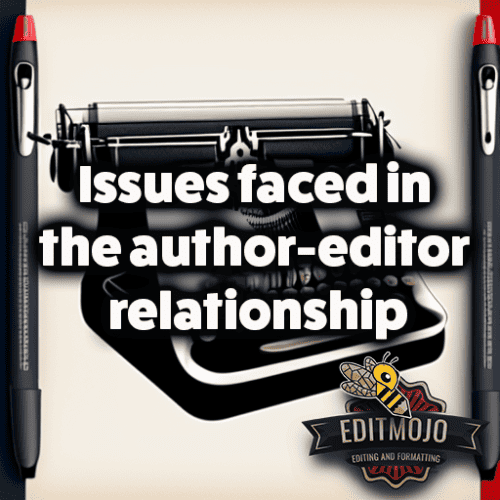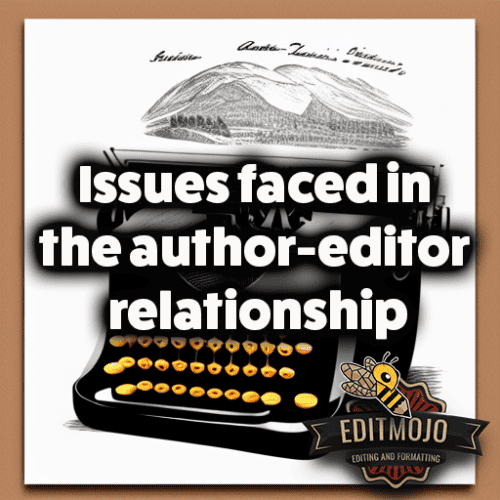Issues faced in the author-editor relationship
Issues faced in the author-editor relationship. The world of publishing is a complex labyrinth of creativity, precision, and collaboration. At the heart of it lies the delicate dance between authors and editors, an intricate waltz that, when perfectly synchronized, can result in truly exceptional literature. But what happens when the steps falter, and the music is out of sync? In this article, we delve into the complications of the author-editor relationship, the problems that arise, and the solutions that can create harmony once again.
Key Takeaways
| Issue | Impact | Solution |
|---|---|---|
| Communication Breakdown | Can lead to misunderstandings, disrupted creative process | Be clear, concise, and open. Use tools like Google Docs or Microsoft Teams for real-time collaboration and conversation |
| Differing Creative Visions | Can cause frustration and stagnation in the project | Discuss the direction of the piece, its tone, and its structure before diving into the editing process |
| Unrealistic Expectations | Can lead to stress, burnout, and potential fallout | Set realistic timelines, agree on the workload, and be transparent about the process |
| Lack of Respect for Boundaries | Can lead to resentment and conflict | Understand and respect each other’s roles and maintain professional boundaries |
Understanding the Dynamics of the Author-Editor Relationship
Before we can dissect the issues, we need to understand the dynamics of the relationship. The author-editor relationship is a symbiotic one where both parties, while having distinctly different roles, work towards the same goal. The author brings the vision and the raw material, and the editor polishes it, enhancing its strengths and correcting its weaknesses. As Stephen King famously said, “To write is human, to edit is divine.”
In an ideal author-editor relationship, mutual respect, effective communication, and a shared vision reign supreme. But we all know that ‘ideal’ is often as elusive as a unicorn in the wild. And that’s where understanding the relationship dynamics becomes paramount.

The Common Issues in the Author-Editor Relationship
The author-editor relationship is like a marriage. Just like any relationship, there can be disagreements, miscommunication, or different visions. Below are some common problems that often emerge.
Communication Breakdown
We’ve all been there – sending an email and then waiting. And waiting. And then waiting some more. Communication breakdown is a frequent issue in the author-editor relationship. Each party has their style of communication. Some prefer concise emails, others detailed explanations. Add to it the element of virtual communication, and you have a ripe breeding ground for misunderstandings and misinterpretations.
For instance, an editor’s comment about a character might be interpreted by the author as a harsh critique of the entire manuscript. Or an author’s lack of response could be viewed as disinterest or negligence. These are classic examples of miscommunication, leading to tension and, worst of all, a disruption in the creative process.
Differing Creative Visions
Imagine trying to paint a mural with someone who envisions an urban skyline while you see a tranquil countryside. Frustrating, isn’t it? This is what happens when an author and editor don’t share the same creative vision for a project. An author might have an experimental narrative style in mind, while the editor might think a more traditional approach would resonate better with readers.
Take, for example, the famous disagreement between Raymond Carver and his editor, Gordon Lish. Carver’s minimalist style, now renowned, was actually a result of Lish’s heavy editing, which initially upset Carver.

Unrealistic Expectations
Another common issue is unrealistic expectations. An editor might expect an author to deliver a polished manuscript in an impossible timeline, or an author might expect their editor to turn around a 400-page manuscript in a week.
This mismatch often leads to stress, burnout, and sometimes even a fallout. Case in point is the tale of Harper Lee and her editor Tay Hohoff. The creation of “To Kill a Mockingbird” was not a walk in the park. It was a product of a two-year-long grueling process, testing the patience of both parties involved.
Lack of Respect for Boundaries
Just as a football game has lines marking the playing field, the author-editor relationship needs boundaries. Crossing these professional lines can lead to resentment and conflict. For example, an editor overstepping their role by rewriting substantial parts of a manuscript without consultation, or an author refusing to consider any changes suggested by the editor.
The Impact of These Issues on the Publishing Process
Unresolved issues between authors and editors can lead to a domino effect in the publishing process. Delays become frequent, the quality of the work may decrease, and relationships may become strained, as was seen in the tumultuous relationship between author Thomas Wolfe and his editor Maxwell Perkins. The constant back-and-forths and disagreements stalled the publishing process and created an almost unbearable tension.
Strategies to Address and Overcome These Issues
Although these issues can seem daunting, they are not insurmountable. Here are some strategies to foster a healthy, productive author-editor relationship.
Fostering Open Communication
Communication is the lifeblood of any relationship. The key is to be clear, concise, and open. Using tools like Google Docs or Microsoft Teams, which allow real-time collaboration and conversation, can help minimize misunderstandings.
Developing a Shared Vision
Establishing a shared vision from the get-go is crucial. It is essential to discuss the direction of the piece, its tone, and its structure before diving into the editing process. Remember, it’s not about compromising; it’s about finding a creative middle ground.
Setting Realistic Expectations
The phrase “Rome wasn’t built in a day” is pertinent here. Good writing takes time, and so does good editing. Setting realistic timelines, agreeing on the workload, and being transparent about the process can prevent misunderstandings and mitigate stress.

Maintaining Professional Boundaries
Understanding and respecting each other’s roles is pivotal. An editor’s job is to refine the author’s work, not rewrite it. Conversely, an author needs to be open to constructive criticism and remember that the editor’s aim is to improve the manuscript.
Case Studies: Successful Author-Editor Relationships
Despite the potential pitfalls, successful author-editor relationships do exist. Take the case of J.K. Rowling and her editor Barry Cunningham. Their relationship, based on trust, respect, and open communication, not only led to the successful Harry Potter series but also forged a lifelong friendship.
Or consider the relationship between Ernest Hemingway and his editor Maxwell Perkins. Despite Hemingway’s notoriously difficult personality, their shared vision and mutual respect led to some of the greatest classics of 20th-century literature.
Conclusion (Issues faced in the author-editor relationship)
The author-editor relationship is a delicate dance, fraught with potential missteps. But with mutual respect, open communication, a shared vision, and realistic expectations, this dance can become a beautifully synchronized ballet that produces literary masterpieces.
No relationship is without its challenges. And while the path may sometimes be rocky, as Harper Lee wisely stated, “Real courage is when you know you’re licked before you begin, but you begin anyway and see it through no matter what.” It’s this courage, resilience, and dedication that can turn the author-editor relationship from a minefield into a goldmine.
Additional Resources (Issues faced in the author-editor relationship)
If you’re interested in delving deeper into the author-editor relationship, here are a few resources that might help:
- “The Forest for the Trees: An Editor’s Advice to Writers” by Betsy Lerner
- “What Editors Do: The Art, Craft, and Business of Book Editing” by Peter Ginna
- A series of webinars on effective communication and relationship building by Editage Insights.
Remember, the path to publishing success is a journey best taken together. Happy writing, and happier editing!
Top Five Questions and Answers
| Question | Answer |
|---|---|
| What is the significance of the author-editor relationship in the publishing process? | The author-editor relationship is central to the publishing process. While authors bring the vision and raw material, editors refine it. A harmonious relationship between the two can result in exceptional literature. |
| What common issues are faced in the author-editor relationship? | Common issues include communication breakdown, differing creative visions, unrealistic expectations, and lack of respect for boundaries. |
| How can these issues impact the publishing process? | Unresolved issues can lead to frequent delays, decreased work quality, and strained relationships, which can stall the publishing process. |
| What strategies can help overcome these issues? | Strategies include fostering open communication, developing a shared vision, setting realistic expectations, and maintaining professional boundaries. |
| Are there successful examples of the author-editor relationship? | Yes, successful relationships exist, such as that between J.K. Rowling and her editor Barry Cunningham, and Ernest Hemingway and his editor Maxwell Perkins. These relationships were based on trust, respect, open communication, and shared vision. |
